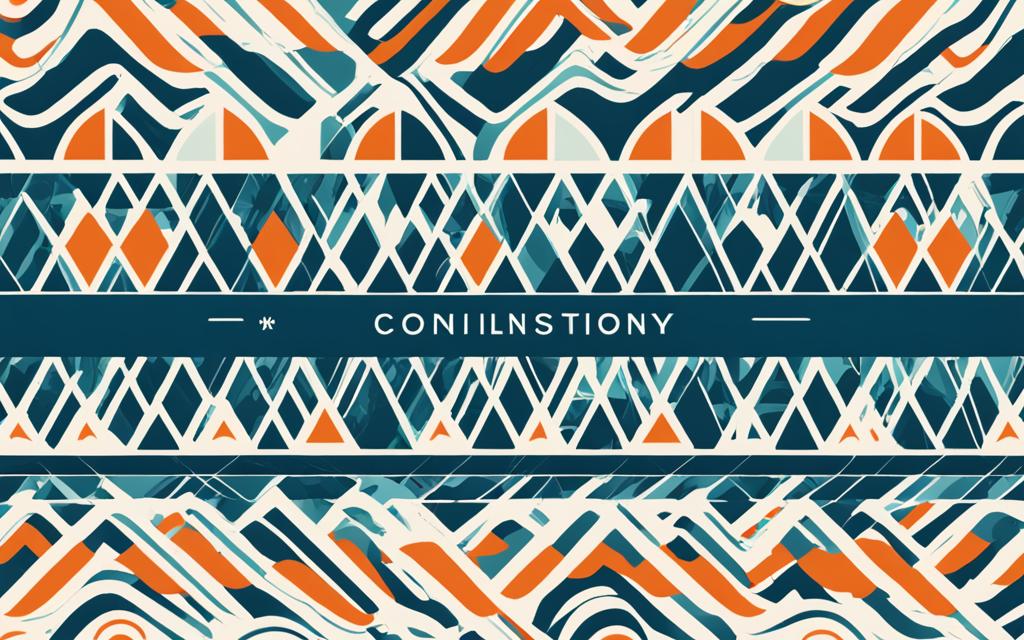Table of Contents
Consistency in design is crucial for creating a cohesive brand presence that resonates with your audience. When different design elements work together seamlessly, they form a unified identity that instantly communicates your brand’s values and message. This applies to all aspects of design, from branding to packaging to UI/UX.
By maintaining consistency in your graphic design, you can build a strong relationship with your audience. They can easily recognize and connect with your brand, leading to increased trust and loyalty. Consistency also saves valuable time in the design process as it eliminates the need to reinvent the wheel for every new project.
Furthermore, consistent design ensures clear and professional communication. When your design elements align harmoniously, they convey your message effectively and make a lasting impact on your audience.
Stay tuned to learn more about what consistency in graphic design refers to and why it is important in various areas, such as web design, marketing, and social media.
What Does Consistency in Graphic Design Refer To?
In the world of graphic design, consistency is a fundamental principle that encompasses the use of connected design elements to effectively communicate with the audience. When design elements are consistent, they work together harmoniously, creating a cohesive and unified visual experience. Consistency also plays a crucial role in establishing a strong design context, where separate pieces of work are recognized as being related to each other.
A prime example of consistency in graphic design can be seen in the branding of renowned companies like McDonald’s. The iconic golden arches and the familiar color scheme are consistent branding elements that are used across various platforms and materials. This consistent use of design elements helps create familiarity and ensures that the brand is easily recognizable to its audience.
Consistency in design goes beyond simply maintaining a visual aesthetic. It contributes to the overall quality of the design by creating a sense of cohesion and professionalism. When design elements are consistently applied, they establish a visual language that guides the audience through the intended message or story.
By employing consistency in graphic design, designers can enhance the audience’s understanding and engagement with the design. Whether it’s through a consistent color palette, typography, imagery, or layout, a consistent design approach helps establish a strong connection between the audience and the design itself.
Why is Consistency Important in Graphic Design?
Consistency is of utmost importance in graphic design for several compelling reasons. Firstly, it builds a strong and lasting relationship with the audience by creating familiarity and instilling a sense of trust. When design elements remain consistent across different projects and platforms, the audience can easily recognize and relate to the visual identity of a brand or company.
Secondly, consistency saves valuable time in the design process, particularly when working on large-scale projects that involve multiple pieces of artwork. By establishing a consistent style, color palette, typography, and set of assets to work with, designers can streamline their workflow, eliminating the need to start from scratch for every project. This not only increases efficiency but also ensures that the design maintains a cohesive and united message.
Lastly, consistency in design enhances the overall professionalism and effectiveness of the work. By adhering to a consistent visual language and style, designers can effectively communicate their intended message to the audience. Clear and consistent design choices help convey information in a concise and visually appealing manner, leaving a lasting impression on viewers.
Consistency in graphic design is like a language that speaks to the audience. It guides their understanding and creates a seamless experience that resonates with their visual expectations.
In conclusion, consistency is a powerful tool in graphic design that not only builds a strong relationship with the audience but also saves time in the design process while elevating the professionalism of the work. By establishing a consistent visual identity and style, designers can create impactful designs that effectively communicate their intended message.
How to Create Consistency in Graphic Design Projects
Creating consistency in graphic design projects is essential for establishing a cohesive visual identity that resonates with your audience. Consistency ensures that your design elements work together harmoniously, conveying a unified message and reinforcing brand recognition. Here are some key strategies to help you achieve consistency in your graphic design projects:
- Color: Choose a core color that represents your brand and select a few supporting colors to complement it. Use these colors consistently across your designs to create a recognizable brand palette.
- Typography: Select a core font and a secondary supporting font that complement each other. Use these fonts consistently throughout your designs to establish a visual connection while still allowing for diversity.
- Size and Relationship: Maintain consistency in the size and relationship of design elements. Keep titles, images, and illustrations at consistent sizes to create a sense of rhythm and focus on the content.
- Imagery: Utilize the same imagery, such as photos, illustrations, and icons, across all your design materials. This helps establish visual consistency and reinforces your brand’s identity.
By incorporating these strategies into your graphic design projects, you can create a consistent and cohesive visual identity that resonates with your audience and strengthens your brand’s presence.
Image depicts the importance of creating consistency in graphic design projects
Consistency in Web Design
Consistency in web design is crucial for creating a positive user experience. It ensures that the visual elements and functionality of a website work harmoniously and create a coherent and unified look.
A key aspect of consistency in web design is the navigation elements. By providing consistent navigation across all pages, users can easily move from one page to another and can quickly understand where they are within the site. This helps to enhance usability and reduces confusion.
Consistency also plays a vital role in page layouts, menu structures, and branding elements. By maintaining a consistent layout and structure, users can navigate the website more efficiently and find the information they need without any confusion. Moreover, incorporating consistent branding elements, such as logos, colors, and typography, throughout the site helps to reinforce the brand identity and create a memorable experience for users.
Choosing standard fonts and adhering to brand guidelines are also crucial in maintaining consistency in web design. By using fonts that are consistent with the brand’s style, users will be able to recognize and connect with the brand more easily. Similarly, following brand guidelines ensures that the design elements used are in alignment with the brand’s visual identity, resulting in a cohesive and professional web design.
In summary, consistency in web design is essential for creating a positive user experience. By ensuring consistency in visual elements, functionality, and branding throughout the website, users can navigate the site seamlessly and have a cohesive and unified experience.
Consistent Graphic Design in Marketing
Consistent graphic design plays a vital role in marketing, contributing to the success of a brand in several ways. By creating a consistent look and feel, it helps build brand image and awareness, leaving a lasting impression on consumers. Visual consistency in marketing materials fosters a positive association with the brand, making it easier for people to recall and recognize it.
Furthermore, consistent graphic design is instrumental in creating loyalty and trust among customers. When a brand consistently delivers visually appealing and cohesive design experiences, customers develop a sense of familiarity and reliability. This, in turn, encourages loyalty and fosters long-term relationships with the brand.
Additionally, consistent graphic design enhances the overall user experience. It provides a sense of predictability and control, allowing users to navigate marketing materials with ease. The visual consistency in imagery, typography, and branding elements creates a cohesive visual language that users can quickly understand and connect with.
Visual communication is a powerful tool in marketing, and consistent graphic design plays a significant role in this aspect. People are more likely to remember visuals rather than text, making visual consistency essential for effective communication. By maintaining a consistent design language, brands can convey their message more effectively and leave a lasting impact on their target audience.
In conclusion, consistent graphic design is paramount in marketing as it helps build brand image and awareness, creates loyalty and trust, improves the user experience, and enhances visual communication. By maintaining a cohesive and visually appealing design language, brands can make a lasting impression on their audience and drive success in the competitive marketing landscape.
The Impact of Consistent Graphic Design on Social Media
Consistent graphic design on social media plays a crucial role in creating brand recognition and delivering a unique look and experience. With the overwhelming amount of visual content users encounter on social platforms, it’s essential to have graphics that stand out and leave a lasting impression.
By employing consistent graphic design principles, brands can reinforce their identity and increase awareness. Using recognizable design elements like colors, fonts, and logos across social media platforms helps users associate them with the brand, enhancing brand recognition and recall.
Furthermore, consistent graphic design significantly improves visual communication on social media. Visual content, such as images, is processed faster by the human brain compared to text. By creating unique and consistent graphics, brands can effectively convey their message and engage with their target audience.
Incorporating a consistent graphic design approach results in a stronger brand image and an enhanced user experience on social media. Users are more likely to engage with content that has a cohesive and visually appealing look, which builds trust and increases brand loyalty.
To illustrate the impact of consistent graphic design on social media, consider the following example:
“Our consistent graphic design approach on social media has allowed us to enhance brand recognition and create a unique experience for our audience. By using a consistent color palette and typography across platforms, we’ve developed a visual identity that our followers instantly recognize. This has boosted our engagement rates and increased brand loyalty, resulting in higher conversion rates.”
-Alex Thompson, Social Media Manager at XYZ Brand
By implementing consistent graphic design strategies on social media, brands can leave a lasting impact on their audience, effectively communicate their message, and strengthen their brand image.
Conclusion
Consistency in graphic design is paramount in creating a cohesive and impactful brand presence. It plays a crucial role in building brand image and awareness, fostering loyalty and trust with customers, enhancing the user experience, and improving visual communication.
Whether it’s in web design, marketing materials, or social media, consistent graphic design helps establish a recognizable and unified brand identity. By using consistent design elements, such as colors, typography, and imagery, brands can effectively communicate their message across different platforms and mediums.
Implementing consistency in graphic design not only strengthens brand recognition but also creates a sense of familiarity and trust. When customers encounter consistent design across various touchpoints, it reinforces the brand’s reliability and professionalism.
Furthermore, consistent graphic design greatly impacts marketing efforts. It creates a strong visual presence that builds brand recall and facilitates a deeper connection between the brand and its target audience. Through consistent design, brands can deliver a seamless and memorable user experience, ultimately driving engagement and conversion.
FAQ
What is the importance of consistency in web graphic design?
Consistency in web graphic design is important as it helps create a cohesive brand presence and allows the audience to immediately recognize and understand the connection between different design elements. This builds a relationship with the audience, saves time in the design process, and ensures clear and professional communication.
What does consistency in graphic design refer to?
Consistency in graphic design refers to the use of connected design elements that work together to communicate with the audience. It ensures that separate pieces of work are recognized as being related to each other, creating familiarity and improving the overall quality of the design.
Why is consistency important in graphic design?
Consistency is important in graphic design as it helps build a relationship with the audience by creating familiarity and a sense of trust. It also saves time in the design process and ensures a clear and professional communication of the intended message.
How can I create consistency in graphic design projects?
You can create consistency in graphic design projects by using color to establish a core color scheme associated with the brand and choosing a consistent typography style. Keeping the size and relationship of design elements consistent throughout the project and using the same imagery across all design materials also helps create a sense of consistency.
Why is consistency in web design crucial?
Consistency in web design is crucial for creating a positive user experience. It ensures that the visual elements and functionality of a website work harmoniously and create a coherent and unified look. Consistent navigation elements, page layouts, menu structures, and branding elements help users navigate the website more efficiently.
How does consistent graphic design impact marketing?
Consistent graphic design in marketing helps build brand image and awareness by creating a consistent look and feel that people associate with the brand. It also creates loyalty and trust with customers, enhancing the user experience, and improving visual communication. Visual consistency helps users navigate marketing materials more easily and enhances brand recall.
What is the impact of consistent graphic design on social media?
Consistent graphic design on social media is essential for creating brand recognition and a unique look and experience. It reinforces brand identity and awareness by using recognizable design elements and enhances visual communication. Creating unique and consistent graphics on social media helps strengthen the brand image and effectively engage with the target audience.
What is the conclusion regarding consistency in graphic design?
Consistency in graphic design is vital for creating a cohesive and effective brand presence. It is important in various areas, including web design, marketing, and social media. It helps establish a recognizable and unified brand identity and ensures that design work effectively communicates the intended message.













